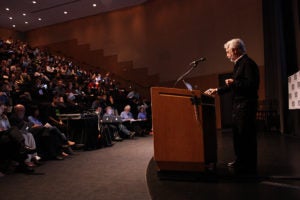April 20, 2012 | Digital Native Media, Engagement, Featured, Keynote, Metrics and Analytics, Transition to Digital
Richard Gingras and Creating the Future of News

The way that we interact with media has gone through several revolutions. Today, the conventional barriers between news production and consumption are undoubtedly gone.
But according to Richard Gingras, head of news products for Google and the first keynote speaker at ISOJ 2012, this is one of the best things that has happened to the media industry. “We’ve effectively put a printing press in everyone’s home. There are no more gatekeepers,” Gingras said.
This is a surprising statement from Google, who is often seen as the mother of all online gatekeepers. But Gingras insists that when it comes to journalism, Google’s true goal is simply providing information to an online audience.
“We will continue to strive to connect the dots, as it were, between consumer interests and knowledge,” Gingras said.
According to Gingras, the news game isn’t just about presenting everything to everyone. The media market is often defined by particular productions and interests. “The media-scape that we are moving in to is one of many niches,” Gingras said. The more that we add, the more that “context and relevance” are necessary in the online world.
Gingras seemed to be in support of structuring information directly for the web rather than transferring print architecture online. He compared it to the way that radio news broadcasting began as a method for reading print articles but grew into its own form of communication.
According to a nice look at some Google statistics, today three-fourths of a news website’s traffic goes directly to a story page rather through the home page, which should force us to think about information design from a different perspective.
The entire structure of content must be adapted to the online environment. Gingras said that the story of the hour must be the top of a “pyramid” and the foundations are the rest of the website. He provided Wikipedia as an example of placing articles above the homepage and said that news websites must structure information in a similar manner.
To Gingras, it’s all about the optimization of your resources and tools. Reporters must learn to work hand-in-hand with their computers. The end of journalism is not nigh, the beginning is here.
ISOJ 2012: Richard Gingras keynote during the 13th Online Symposium on Online Journalism from Knight Center on Vimeo.

